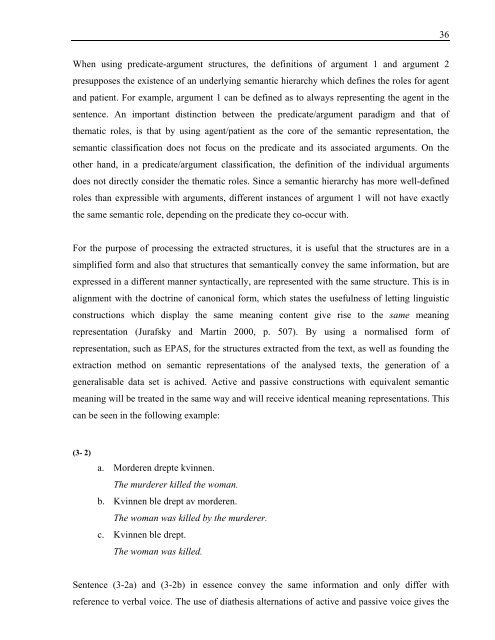Unni Cathrine Eiken February 2005
Unni Cathrine Eiken February 2005
Unni Cathrine Eiken February 2005
You also want an ePaper? Increase the reach of your titles
YUMPU automatically turns print PDFs into web optimized ePapers that Google loves.
When using predicate-argument structures, the definitions of argument 1 and argument 2<br />
presupposes the existence of an underlying semantic hierarchy which defines the roles for agent<br />
and patient. For example, argument 1 can be defined as to always representing the agent in the<br />
sentence. An important distinction between the predicate/argument paradigm and that of<br />
thematic roles, is that by using agent/patient as the core of the semantic representation, the<br />
semantic classification does not focus on the predicate and its associated arguments. On the<br />
other hand, in a predicate/argument classification, the definition of the individual arguments<br />
does not directly consider the thematic roles. Since a semantic hierarchy has more well-defined<br />
roles than expressible with arguments, different instances of argument 1 will not have exactly<br />
the same semantic role, depending on the predicate they co-occur with.<br />
For the purpose of processing the extracted structures, it is useful that the structures are in a<br />
simplified form and also that structures that semantically convey the same information, but are<br />
expressed in a different manner syntactically, are represented with the same structure. This is in<br />
alignment with the doctrine of canonical form, which states the usefulness of letting linguistic<br />
constructions which display the same meaning content give rise to the same meaning<br />
representation (Jurafsky and Martin 2000, p. 507). By using a normalised form of<br />
representation, such as EPAS, for the structures extracted from the text, as well as founding the<br />
extraction method on semantic representations of the analysed texts, the generation of a<br />
generalisable data set is achived. Active and passive constructions with equivalent semantic<br />
meaning will be treated in the same way and will receive identical meaning representations. This<br />
can be seen in the following example:<br />
(3- 2)<br />
a. Morderen drepte kvinnen.<br />
The murderer killed the woman.<br />
b. Kvinnen ble drept av morderen.<br />
The woman was killed by the murderer.<br />
c. Kvinnen ble drept.<br />
The woman was killed.<br />
Sentence (3-2a) and (3-2b) in essence convey the same information and only differ with<br />
reference to verbal voice. The use of diathesis alternations of active and passive voice gives the<br />
36

















